|
|
|
Sort Order |
|
|
|
Items / Page
|
|
|
|
|
|
|
| Srl | Item |
| 1 |
ID:
140435
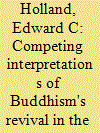

|
|
|
|
|
| Summary/Abstract |
This article uses a multiple methods framework to interrogate notions of religious revival among Buddhists in the Russian republic of Kalmykia. Survey results indicate high levels of self-identification among Kalmyks as Buddhists, as well as general support for the notion that the religion has re-established its place in the public sphere in the post-Soviet period. This straightforward interpretation of religious revival is contested, however, in interviews with religious elites and focus group conversations. Interlocutors in these forums were more critical and more nuanced in their understanding of Buddhism's role in contemporary Kalmykia.
|
|
|
|
|
|
|
|
|
|
|
|
|
|
|
|
| 2 |
ID:
160051
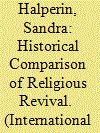

|
|
|
|
|
| Summary/Abstract |
Predictions about the future of the Middle East have proliferated in step with recent events and escalating tensions in the region. This paper highlights the usefulness of historical comparative research for addressing predictive questions and, specifically, those relating to the current Islamic revival. It challenges assumptions that have prevented researchers from exploring this avenue of research; and describes a generally overlooked chapter in modern European history: Europe's nineteenth century revival of militant, literal, religion, and the region-wide, battle it unleashed between religious and secular forces through the region. It then highlights similarities, both in the nature of revivals in Europe and the Middle East and of the socio-economic structures which sustained them. Finally, it suggests how and why the battle between religious and secular forces in Europe came to an end. While, it does not offer predictions for the Middle East, it suggests how comparative insights might contribute to producing better ones.
|
|
|
|
|
|
|
|
|
|
|
|
|
|
|
|
| 3 |
ID:
154372
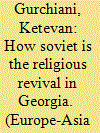

|
|
|
|
|
| Summary/Abstract |
This article explores everyday religiosity in post-Soviet Georgia based on multi-sited fieldwork and applying a genealogical approach. It looks at the use of tactics in negotiations between priests and believers. The article sees negotiations, prevalent in domestic religiosity and embodied practices, as a continuation of everyday Soviet tactics, particularly informal networks (Blat) and moonlighting (Khaltura). To understand how negotiations lead to greater control and an increase in religiosity, the article explores important features of the Georgian Orthodox Church and its specific development. The article concludes that tactics in this specific context strengthen the more powerful and reproduce dependency.
|
|
|
|
|
|
|
|
|
|
|
|
|
|
|
|
| 4 |
ID:
132735
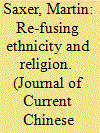

|
|
|
|
|
| Publication |
2014.
|
| Summary/Abstract |
The relation between ethnicity and religion has had a troubled history in the People's Republic of China. Conflating religious practice with ethnic culture is considered to carry the risk of breeding "splittism" - especially in Tibet and Xinjiang. While in the post-Mao era the outright hostility against religion has given way to a religious revival, keeping religion and (nationality) politics separate has remained a major concern for the Chinese Communist Party. Religion is supposed to be a private matter that does not interfere with pol-itics. Against this backdrop, a recent phenomenon in the Tibet Autonomous Region is all the more remarkable: the (re-)fusion of ethnicity and religion under the label of cultural heritage and its protection. This paper approaches this officially endorsed re-fusion ethno-graphically and examines its wider implications. I argue that endorsing religion as an attribute of Tibetan heritage corresponds to the concept of defining public spaces and events in which religious practice is legitimate and expected. Simultaneously, religious practices outside these dedicated spaces and events become even more problematic, leading to everyday Buddhist practices, such as circumambulation, being seen as (and performed as) political acts.
|
|
|
|
|
|
|
|
|
|
|
|
|
|
|
|
| 5 |
ID:
132733
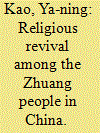

|
|
|
|
|
| Publication |
2014.
|
| Summary/Abstract |
This paper examines two cases of Zhuang religious revival involving multiple actors. It shows how consideration of "superstition" (??, mixin) places some religious practice outside the institutional framework when discussing the modern concept of religion in China. In this paper, I particularly focus on two main dimensions of religious revival among the Zhuang people. The first is a grassroots dimension that involves the revival of a so-called "superstitious" cult in which Zhuang people along the Sino-Vietnamese border carry out shamanic rituals to make offerings to a powerful chief-turned-deity, Nong Zhigao, and his wife. The second dimension is a top-down dynamic and involves a series of projects conducted by Zhuang officials, scholars and business persons, which aim to standardize a Zhuang religion, known as Mo religion. These two cases of religious revival demonstrate the varied strategies utilized by different actors in response to government policies regarding religion in China.
|
|
|
|
|
|
|
|
|
|
|
|
|
|
|
|
| 6 |
ID:
142713
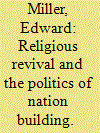

|
|
|
|
|
| Summary/Abstract |
Scholars have portrayed the 1963 ‘Buddhist crisis’ in South Vietnam as a struggle for religious freedom, as a political conspiracy, or as a manifestation of ancient religious beliefs and practices. This paper, in contrast, argues that the crisis emerged from a clash of modernizing visions. The Buddhist-led protests that took place in South Vietnam in 1963 were linked to the Vietnamese Buddhist revival, a nationalist reform movement that began during the early twentieth century. The protests also reflected growing Buddhist anxieties about the Ngo Dinh Diem government's nation-building agenda for South Vietnam. By the time the crisis began, Buddhist leaders had concluded that this agenda (which Diem referred to as the ‘Personalist Revolution’) was incompatible with their plans to realize Vietnam's destiny as a ‘Buddhist nation’. In addition to reinterpreting the origins of the crisis, this paper examines how the course of events was shaped by the personalities and agendas of particular Buddhist and government leaders, and especially by fierce rivalries among members of Diem's family. These internal tensions help to explain the failure of attempts to end the crisis through negotiations, as well as Diem's decision to crush the movement by force in August 1963.
|
|
|
|
|
|
|
|
|
|
|
|
|
|
|
|
| 7 |
ID:
124655
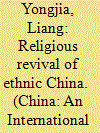

|
|
|
|
|
| Publication |
2013.
|
| Summary/Abstract |
Over the past three decades, Chinese "ethnic areas" (minzu diqu) have experienced widespread religious revival. Religious populations are steadily increasing as the religious infrastructure expands under governmental or non-governmental sponsorship. The restoration of sacred sites appeals to the larger ethnic populations for reasons relating to community and identity (re-)creation. The officially recognised religions are reviving different regimes of transcendence in the ethnically diversified localities. Unofficial, transnational, or radical movements and denominations are engaging in activities either in the sphere of underground proselytising or non-governmental organisation (NGO) instruments. Popular religions are being legitimised through ethnic renaissance and are being embraced by astonishingly large populations. They are also being commercialised by local state agents who are given incentives to generate revenue by translating invented traditions into tourist attractions. Ancestor veneration and the Daoist rituals of consulting almanacs, geomancy, horoscopes and spirit mediums are seasoned with ethnic flavour. However, growing social, political and economic disparities are engendering greater anxiety among people who are seeking answers through the old ways such as oracle reading, mask dances, sutra chanting or karma fairs. The flow of capital, symbols, ideas and practices nationally and globally also poses unprecedented problems of religious pluralism in these increasingly mobile multi-ethnic areas.
|
|
|
|
|
|
|
|
|
|
|
|
|
|
|
|
|
|
|
|
|